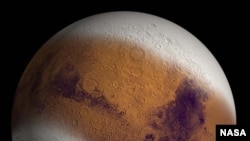A few hundred thousand years ago, the Red Planet wasn't nearly as red as it is today, planetary scientists tell VOA.
That's the latest bit of information that adds to the fairly steady stream of news challenging our notion of Mars as a dry, dusty planet.
The Mars it is a changin'
Today's new research suggests our nearest neighbor has been living through an ice age, and has been warming back up for the past 370,000 years or so.
Scientists in Texas, Colorado, and Missouri published their findings in Science journal
VOA spoke with University of Texas geophysicist Isaac Smith about the new research, which is based on detailed radar measurements from Martian ice caps.
He says Mars has periodic ice ages, just like Earth. "The last ice age maximum would have been about 600,000 years ago," he told VOA, "and the next is 500,000 in the future.
But the cool thing is that during these maximums, the planet "can be covered in white ice."
As in: distinctly less red.
But beyond having way more ice on its surface, when it comes to a Martian ice age, Smith says to forget a lot of what you think should happen during an ice age.
Say What?
For one thing, he says "the polar caps would be smaller," because Martian poles actually warm up during an ice age.
Part of the reason is that Mars has a much more profound tilt than Earth, as well as a much more elliptical orbit around the sun. That, along with the planet's thin atmosphere, means little changes like tilt and distance from the sun can have a big impact.
But in practical terms, warmer poles mean there's a lot more water in the atmosphere.
Smith says, "usually the ice goes to the mid-latitudes between 30 and 60 degrees, where it can build up several meters of thickness," making the red planet look more white than red, even to the naked eye.
"Cool to think about isn't it?" Smith says.
The more we understand how Mars has changed over the years, the more it informs scientists about where to look as astronomers continue their quest to find something that is, or was, alive somewhere else in the universe.
One of the keys to life, is water, and the more we learn about Mars, the more evidence we have, that despite appearances, it can be a fairly watery place.









